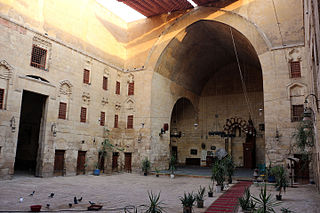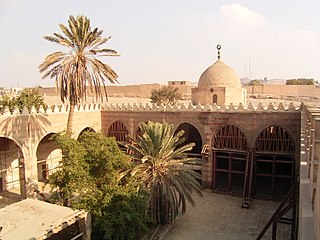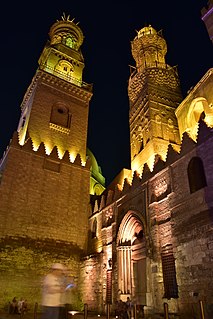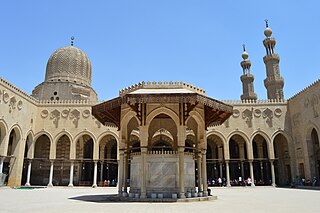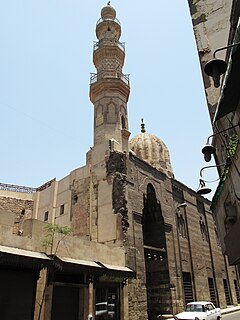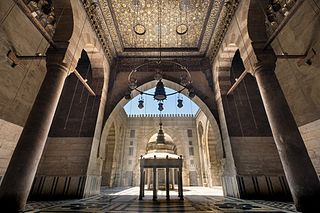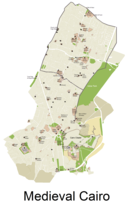Tomb of Salar and Sangar al-Gawli is located near the Ibn Tulun Mosque along Saliba Street in Medieval Cairo. It contains the joint mausoleums of Sayf el-Din Salar and Alam el-Din Sangar el-Gawli, powerful Mamluk emirs in the early 14th-century. The latter built the complex which also contains a madrasa for the Shafi'i school of jurisprudence and khanqah for the Sufi community. [1]
Saliba Street,, which literally means "Cross Street", is one of the old main streets in Islamic Cairo, Egypt. It runs from the Cairo Citadel in the north to the Mosque of Ibn Tulun in the south. The street is the site of many old buildings, including schools, mosques, hospitals, and mausoleums. Saliba Street is the location of the largest mosque in Cairo and one of the oldest mosques in Africa, Ibn Tulun Mosque, which is one of the very few remaining Abbasid Mosques found in Cairo after the burning of the Fustat.

Islamic Cairo is a part of central Cairo around the old walled city and around the Citadel of Cairo which is characterized by hundreds of mosques, tombs, madrasas, mansions, caravanserais, and fortifications dating from the Islamic era. In 1979, the United Nations Educational, Scientific and Cultural Organization (UNESCO) proclaimed Historic Cairo a World Cultural Heritage site, as "one of the world's oldest Islamic cities, with its famous mosques, madrasas, hammams and fountains" and "the new centre of the Islamic world, reaching its golden age in the 14th century."
Sanjar ibn Abdullah Alam al-Din Abu Sa'id al-Jawli was a powerful Mamluk emir and the Governor of Gaza and much of Palestine between 1311–20 during the sultanate of an-Nasir Muhammad and then again for a brief time in 1342 during the reign of the latter's son as-Salih Ismail. Prior to his first term as governor, al-Jawli briefly served as the Emir of Shawbak in Transjordan and before his second term as Gaza's governor, he was appointed Governor of Hama for three months.
The structure has various noteworthy features. The ones that most catches the eye are the two juxtaposed jelly-mold domes over the tomb chambers of Salar and Sangar. The fine square lines of the base with its trefoil windows give it a slightly Italianate look. Within the Gawaliyya; named used by locals to describe both Tombs, there is a long, vaulted passage that leads to an unknown sheikh's tomb, which is said to have the oldest stone dome in Cairo. The chamber of Sangar on the right is much better preserved than Salar's chamber next to it. The Carved stone screens in the corridor are unique and famous for the Mamluk Era.

Trefoil is a graphic form composed of the outline of three overlapping rings used in architecture and Christian symbolism. The term is also applied to other symbols of three-fold shape.
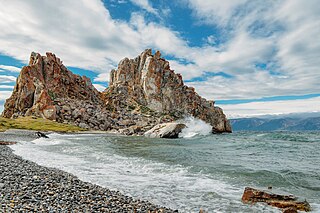
Rock or stone is a natural substance, a solid aggregate of one or more minerals or mineraloids. For example, granite, a common rock, is a combination of the minerals quartz, feldspar and biotite. The Earth's outer solid layer, the lithosphere, is made of rock.
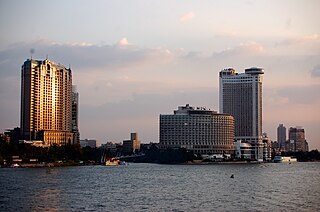
Cairo is the capital of Egypt. The city's metropolitan area is one of the largest in Africa, the largest in the Middle East, and the 15th-largest in the world, and is associated with ancient Egypt, as the famous Giza pyramid complex and the ancient city of Memphis are located in its geographical area. Located near the Nile Delta, modern Cairo was founded in 969 CE by the Fatimid dynasty, but the land composing the present-day city was the site of ancient national capitals whose remnants remain visible in parts of Old Cairo. Cairo has long been a centre of the region's political and cultural life, and is titled "the city of a thousand minarets" for its preponderance of Islamic architecture. Cairo is considered a World City with a "Beta +" classification according to GaWC.
